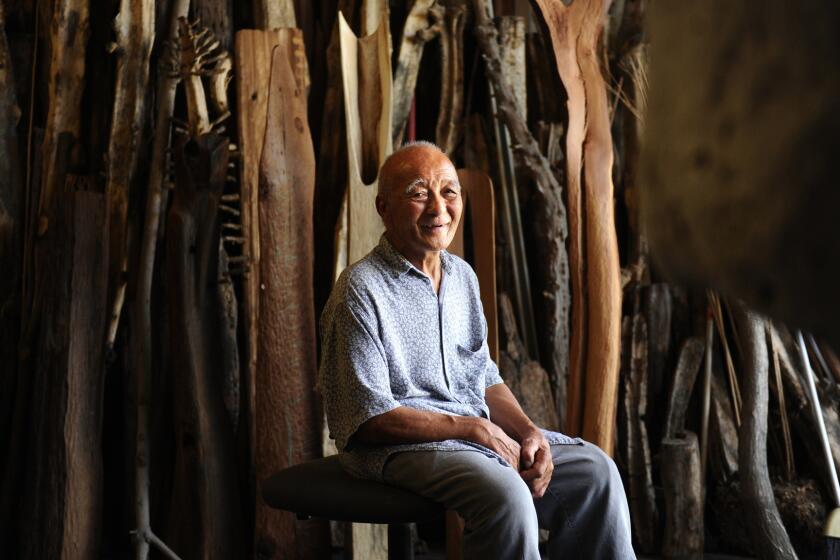Sculptor Kenzi Shiokava, who transformed discarded wood into magnetic totems, dies at 82
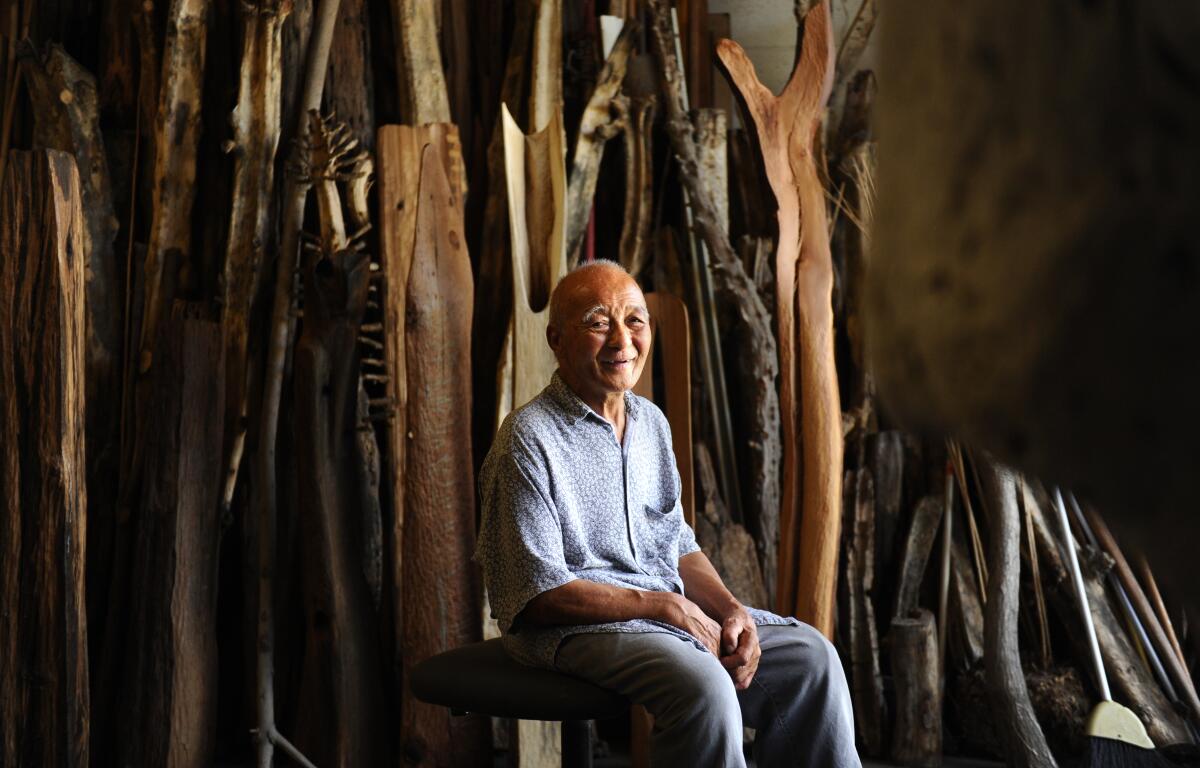
- Share via
Kenzi Shiokava, who died June 18 at the age of 82 from chronic conditions exacerbated by injuries related to a recent car accident, became a sculptor more by chance than intention. It was the early 1970s, and he was completing his fourth year of undergraduate studies at the Chouinard Art Institute.
When he’d enrolled at the school, Shiokava had set his sights on becoming a painter. But a graduation requirement obligated him to complete a course in sculpture. The very idea filled him with doubt. “Two weeks went by and I didn’t have a single idea of what to do,” Shiokava told The Times in a 2016 profile.
Martinez wrote ‘500 Años del Pueblo Chicano/500 Years of Chicano History in Pictures,’ a bilingual photo book with copious captions that illustrated the history of Chicanos in the Southwest.
He ended up finding the answer in his own backyard. One day, as he tidied up the garden of his Highland Park home, he came across several pieces of wood he had accumulated, including an old railroad tie from the Angel’s Flight funicular in downtown Los Angeles.
“I started cleaning some of the wood and I realize: ‘That’s it! It’s wood!’” recalled Shiokava. “It has a history. It’s right there. I was so excited — nothing else mattered.”
He transformed the tie, along with the other pieces of wood he had gathered, into a series of vertical, totemic figures that he displayed in Chouinard’s gallery in 1972. The exhibition drew the attention of L.A. gallerist Joan Ankrum who gave the artist a solo show.
After that, Shiokava never looked back. In fact, it was work in the style of those early wooden totems, carefully sculpted from dead tree trunks and reclaimed telephone poles — pieces that felt more like spirits than objects — which drew the attention of a pair of curators affiliated with the Hammer Museum more than four decades later. Those curators, Aram Moshayedi and Hamza Walker, ended up including a large selection of Shiokava’s work in the 2016 “Made in L.A.” biennial.
At 78 years of age, Shiokava became a breakout star of the show — profiled in international media and name checked in W magazine. It was an unlikely turn for the artist who, throughout his life had operated at the margins of the Los Angeles art world. And who had made his living not as an artist, but as a gardener. Among his clients was actor Marlon Brando, who counted one of Shiokava’s pieces in his personal art collection.
Shiokava, whose death was first announced on social media by the Japanese American National Museum and was confirmed to The Times by his niece Xantipa Reed, was a radiant, personable figure, far more preoccupied with the process of creation than in glad-handing in the gallery circuit. One of his favorite activities? Attending the live jazz performances at the Los Angeles County Museum of Art and dancing with wild abandon.
When artist Kenzi Shiokava received a telephone call from a pair of curators organizing this year’s “Made in L.A.” biennial at the Hammer Museum, he says he had little clue of the meteoric effect it would have on his life.
“He was the kind of person who, up until his death, all he wanted to do was to be in his studio,” says Moshayedi, currently the Robert Soros curator at the Hammer. “The time he spent in the studio, it was a completely different temporality. Works would hang out there in various states of incompletion for decades ... and new objects would enter the studio and they may or may not become parts of works that were sitting in various states of dormancy.”
Even after the Hammer exhibition began to draw the attention of the media and museums and galleries, Shiokava remained committed to his vision. “He had willfully decided after that attention to remain working in the way that he had established for himself,” says Moshayedi. “He was not going to get caught up in the speed and intensity of the contemporary art world.”
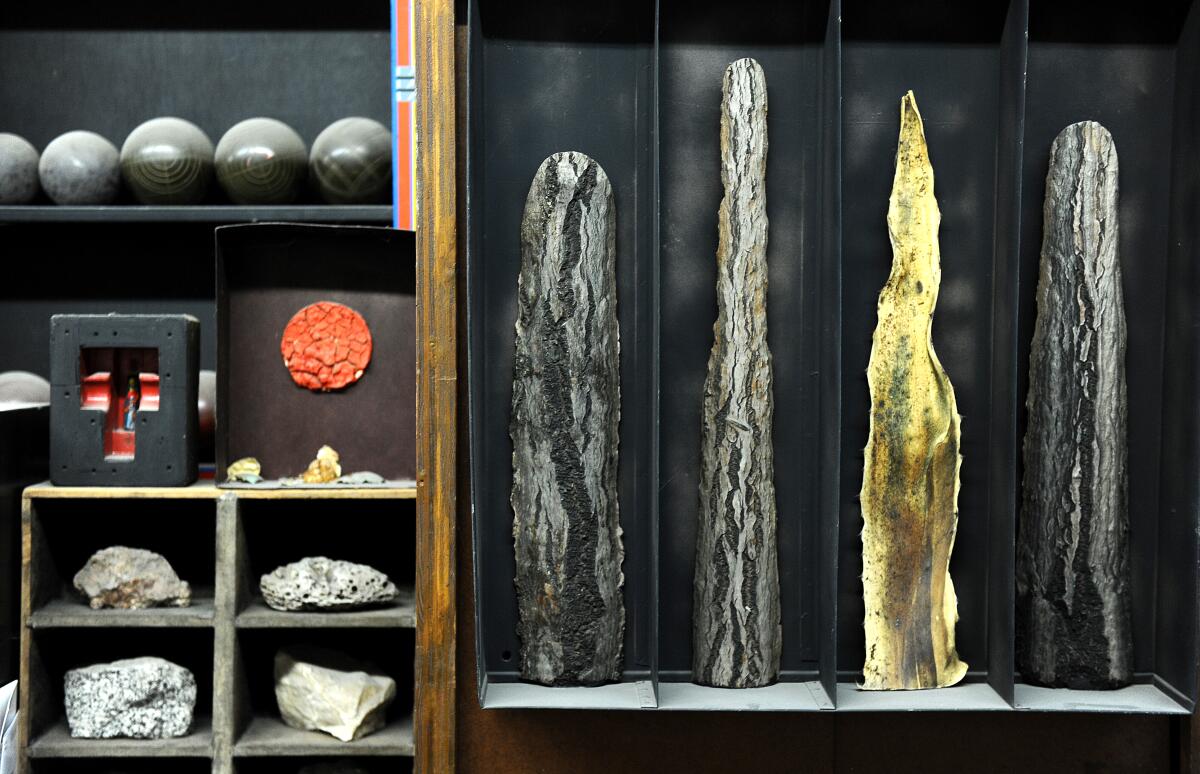
Before the Hammer exhibition, Shiokava had steadily shown his sculptures and assemblages in museums and in galleries around Southern California, including shows at the Museum of Contemporary Art Los Angeles, the Oceanside Museum of Art and Jack Tilton Gallery in Culver City. And while the occasional collector would materialize in his studio, broader commercial success proved elusive.
But the biennial catapulted him into institutional consciousness.
As part of the Hammer exhibition, he received the $25,000 Mohn Public Recognition Award. In 2018, he was included in a Pacific Standard Time exhibition at the Japanese American National Museum: “Transpacific Borderlands: The Art of Japanese Diaspora in Lima, Los Angeles, Mexico City and Sao Paulo.”
The following year, Ben Maltz Gallery at the Otis College of Art and Design staged a solo survey of his work.
A review of that show by critic Geoffrey Mak in Artforum described his work pieces as having “an almost spiritual function.” Indeed the show’s title was “Spiritual Material.” The assemblages, which included collections of dead leaves, wrote Mak, “allude to the passing of life; the artist might be the filter, gathering and reinfusing these objects with latent purpose.” As Times reviewer Leah Ollman wrote of the works in the show, “the continuity between matter and spirit can be viscerally felt when standing before these fellow vertical bodies rising from the earthly plane.”
The artist always expressed deep gratitude for the attention he received late in his career. As he told KPCC in a 2016 interview: “Now I know my work is going to survive me.”
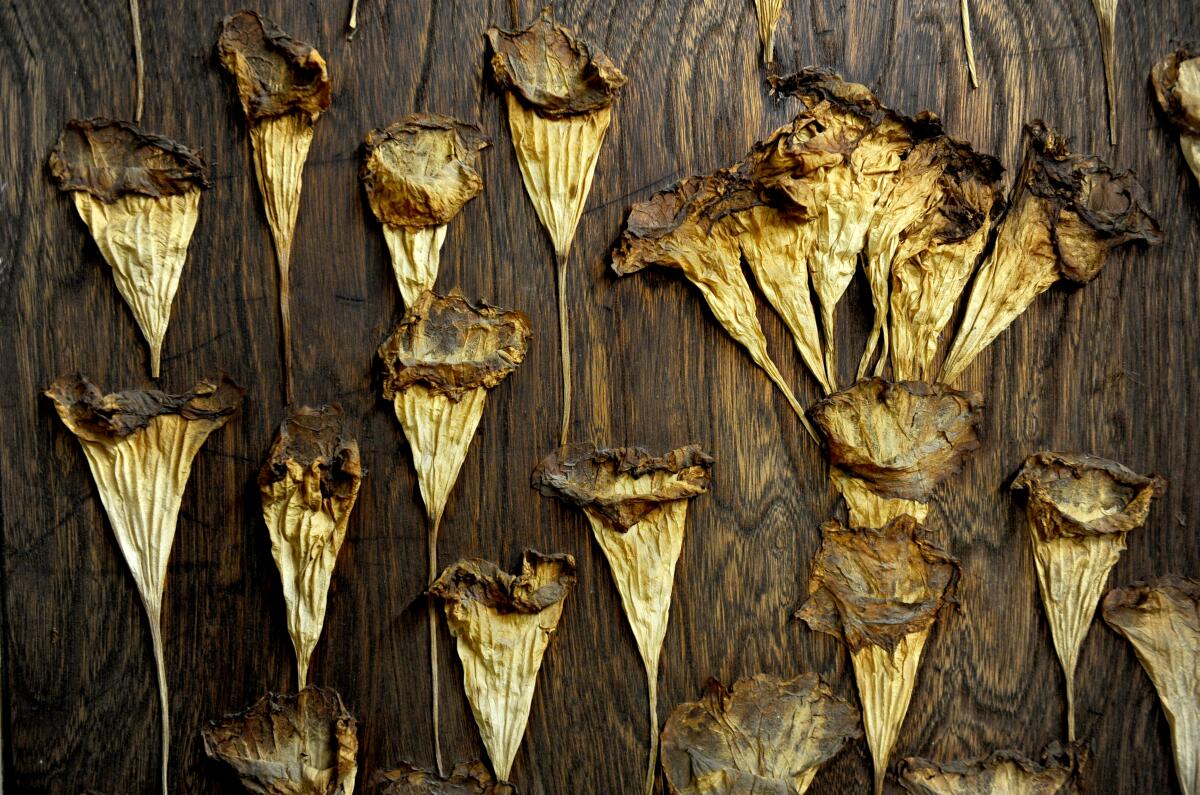
Kenzi Shiokava was born on Aug. 29, 1938, in Santa Cruz do Rio Pardo, Brazil, to a pair of Japanese shopkeepers. From the time he was a boy, he said he saw something “sacred” in art but never imagined it might become a career.
He ended up in the U.S. in 1964 after a friend in the Brazilian military offered him a free seat on a military flight to Los Angeles. On the strength of a few paintings and sketchbooks, he was accepted at Chouinard (which later became CalArts), where he graduated with a bachelor’s degree in fine arts in 1974. He went on to complete a master’s degree in fine arts at Otis in 1974.
Over more than four decades, Shiokava produced sculptures and assemblages that were inspired by Brazilian and Japanese motifs, as well as influences he encountered in Los Angeles — namely, a generation of Black American assemblage artists such as Betye Saar, Noah Purifoy and John Outterbridge. In 1994, he was the subject of a solo show at the Watts Towers Arts Center.
The curators for the Hammer’s biennial found Shiokava’s work after seeing his name listed in a group show that had occurred more than a decade prior, then doing some serious sleuthing to track down his whereabouts and a phone number. He was right where he had been for years: living and working out of a studio in Compton.
In a 2016 interview with The Times, Walker, who is now director at the arts nonprofit LAXART, said Shiokava’s under-the-radar profile could be attributed to his reticence toward self-promotion but also the nature of his work and the communities he was part of. “He circulated in a very different, very regional area — a region within a region,” he said. Plus, “he doesn’t fit any category, but he fits all of them.”
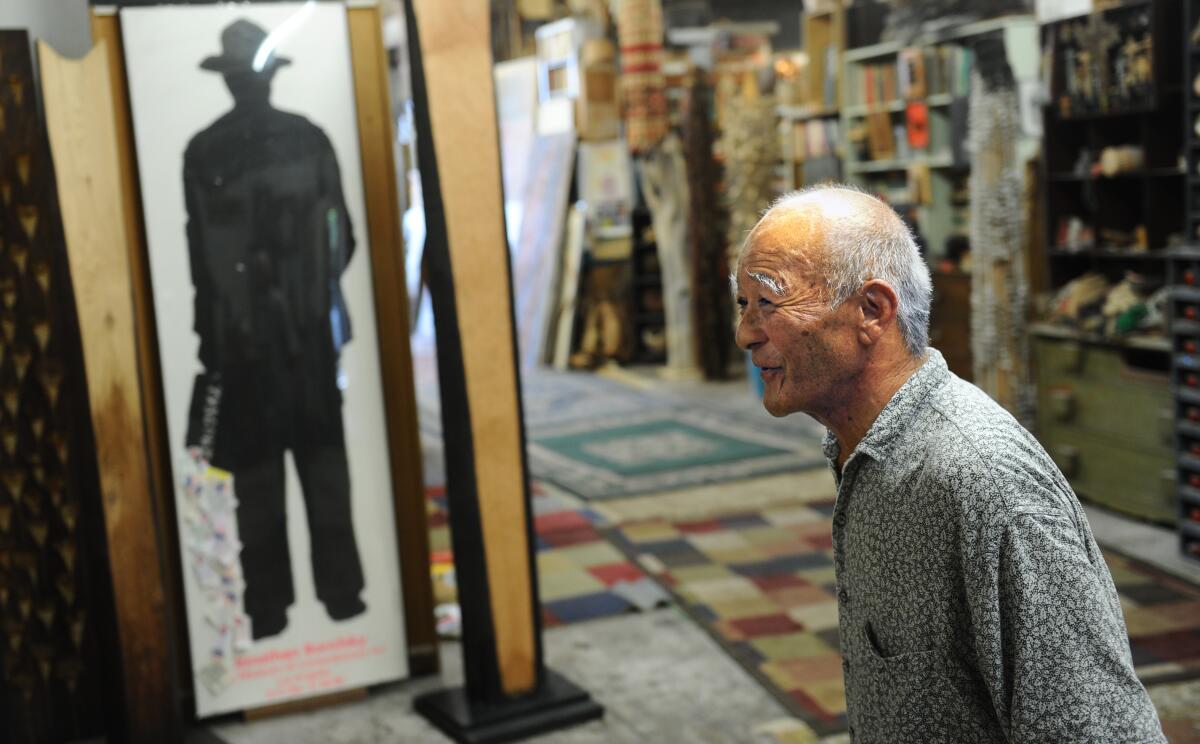
To support his artistic career, Shiokava worked as a gardener for much of his life — a day job he far preferred over teaching. “Too stressful,” he once told The Times. “Gardening is much more interesting to me.”
It was in that line of work that he got a gig cleaning a fish pond at a fancy home in the Hollywood Hills. That home belonged to Brando, for whom he would labor for more than 20 years. The two developed a cordial relationship. “He would say, ‘Kenzi, you make me so happy,’” Shiokava later told KPCC.
Through Brando, he met another prominent Hollywood collector: Jack Nicholson, who also acquired a sculpture. After delivering the piece, Shiokava kept the wooden crate that the work had been transported in so that he might transform it into something new.
“I think he was ahead of society because he believed that you could use trash to make art,” says Reed, his niece. “It was important for us to see beauty in the things people throw away. He believed in recycling as an art form. There is beauty in everything — you just have to look for it.”
For gardener-turned-artist Kenzi Shiokava, new show proves wood is the ultimate ‘Spiritual Material’
Kenzi Shiokava, born 1938, has an academic résumé that reads like those of many established L.A. artists: bachelor’s in fine arts from Chouinard (later CalArts), MFA from Otis College of Art and Design.
After retiring from gardening, Shiokava focused exclusively on his art — working out of his Compton studio for more than two decades. In addition to Reed, he is survived by three sisters — Lourdes Larkins, Miyoko Hilton, Lucia Teraishi — all based in Los Angeles, as well as a brother, Airton Shiokava, who lives in Brazil. Also among his surviving family members are his niece Hime Dequeiroz and a nephew, Glen Teraishi.
In 2016, when Shiokava was asked by KPCC reporter John Rabe if he was religious, the artist explained that he was Catholic.
“I have lots of faith,” he said, pointing at the sky. “Because now I’m more there than here.”
More to Read
Start your day right
Sign up for Essential California for the L.A. Times biggest news, features and recommendations in your inbox six days a week.
You may occasionally receive promotional content from the Los Angeles Times.
